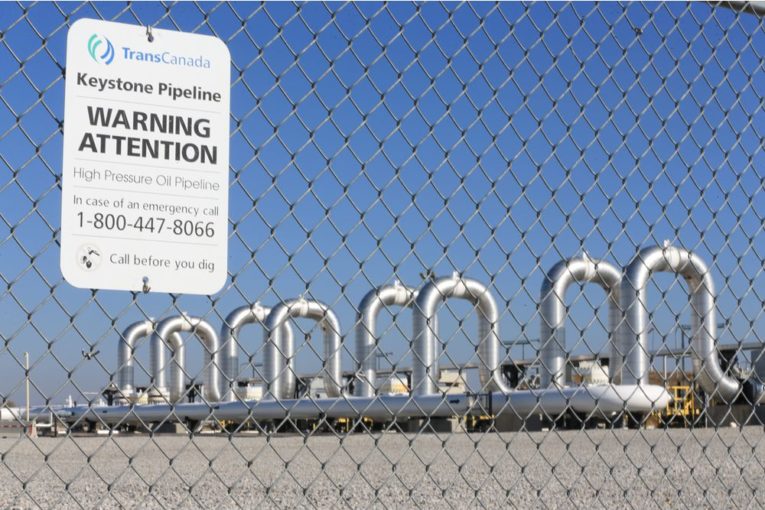
CALGARY – A U.S. federal judge dealt TransCanada Corp. a new setback on Thursday in its years-long push to build the Keystone XL pipeline, as competing export pipeline projects celebrated major milestones on the same day.
U.S. District Court Judge Brian Morris issued a ruling Thursday in Montana requiring the State Department to conduct an environmental assessment of the new Keystone XL route through Nebraska.
The judge ruled that a new assessment was necessary because the Nebraska Public Utilities Commission approved the US$8-billion pipeline along an alternative route through the state, rather than the company’s desired route, and because that route had not been properly studied.
“We’re reviewing the decision,” TransCanada spokesperson Matthew John said in an email following the ruling.
The Calgary-based pipeline company had planned to begin preliminary work on the project, which would ship 830,000 barrels of oil per day from Alberta to the U.S. Gulf Coast, later this year but the ruling adds new uncertainty to the potential construction timeline.
Meanwhile, and on the same day, rival Enbridge Inc. announced the start of construction on its own new export project, Line 3, and the National Energy Board cleared Kinder Morgan Canada to begin construction on the majority of the Trans Mountain expansion project.
For Keystone XL, TransCanada is preparing for one legal challenge to its route approval later this year and Thursday’s development could force the U.S. State Department to undertake further reviews.
“This is an order that is ordering the Department of State to do some work,” said former TransCanada executive Dennis McConaghy, who has written an insider’s account of the Keystone XL pipeline in a book titled Dysfunction: Canada After Keystone XL.
McConaghy said the judge’s order was based on a “technicality” as the Department of State’s environmental impact assessment of the project was in 2014 and U.S. President Donald Trump approved the project in 2017 before the Nebraska commission issued its approvals along the alternative route the same year.
“This is not good but it’s expected,” he said.
Now the State Department can either appeal the judge’s decision or argue that work the U.S. federal government conducted on the alternative route for the Bureau of Land Management, in the Department of the Interior, should satisfy the judge’s order.
Either way, McConaghy said the ruling was a setback for the project and neither option would placate opponents.
Indeed, environmental and other opposed groups said the ruling was proof the project would never be built.
“What we have here is really another potential nail in the coffin, which is a supplemental (Environmental Impact Statement), and if there are any findings in that supplemental EIS that would modify the allegedly approved mainline alternative route, then that could affect the approval,” said Brian Jorde, a lawyer with Omaha-based Domina Law, which represents landowners opposed to Keystone XL.
Domina Law has appealed the approval of Keystone XL to the Nebraska Supreme Court on the basis that the state’s utilities commission did not have the authority to consider alternate routes. Jorde said he expects a decision on that case by the end of the year.
What we have is another potential nail in the coffin, a supplemental (Environmental Impact Statement), and if there are any findings in that, that would modify the allegedly approved mainline alternative route, that could affect the approval
Brian Jorde, Keystone XL opponents’ lawyer
Given the continued delays to Keystone XL, trade spats with the U.S. and Saudi Arabia, some groups have called for TransCanada to reconsider its $15.4-billion Energy East pipeline to Atlantic Canada.
“You’d have to believe that Keystone XL was lost before (Energy East) was back on the table,” McConaghy said, adding, “No one is doing Energy East with (federal bill) C-69.”
TransCanada proposed the Energy East project in 2014 but cancelled the project in 2017 after the federal government announced a new, more stringent review process for energy and pipelines.
Bill C-69 expands the scope of pipeline and environmental regulators in Canada to evaluate whether a pipeline should be built based on, among other considerations, a gender-based analysis and analysis of a project’s contributions to both upstream and downstream emissions.
While Keystone XL continues to face new challenges, competing export pipelines celebrated important milestones Thursday and are gearing up for construction.
Natural Resources Minister Amarjeet Sohi and Enbridge Inc. vice-president Leo Golden announced on Thursday the beginning of construction on the company’s Line 3 replacement project in Manitoba.
The Line 3 replacement project will roughly double the capacity of the line to 760,000 bpd, allowing Canadian oil companies to send more crude to refineries in the U.S. Midwest.
In addition, the RCMP in British Columbia began dismantling a protest camp on Thursday that had disrupted progress at the end point of the 590,000-bpd Trans Mountain expansion pipeline project in Burnaby.
In addition, the National Energy Board announced Thursday it was granting permission for the project to begin construction on the majority of the pipeline route.
Trans Mountain can now begin construction between Edmonton and Kamloops, B.C. The route between Kamloops, in the province’s interior, and Burnaby, at tidewater in the Vancouver suburbs, has not yet been approved and detailed route hearings are scheduled to begin on those final portions in October.
Kinder Morgan Canada Ltd. has been preparing to begin construction on the Trans Mountain pipeline in Alberta and eastern British Columbia at the end of August. The federal government will take ownership of the project shortly thereafter, once the previously announced $4.5-billion deal to acquire the pipeline and expansion from the company closes next month.
• Email: [email protected] | Twitter: geoffreymorgan
You can read more of the news on source
